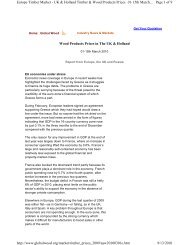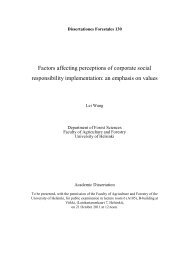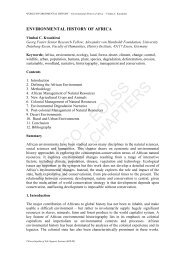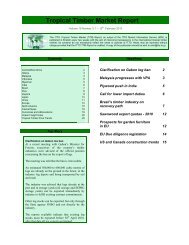ICT and e-Business in the Pulp, Paper and Paper ... - empirica
ICT and e-Business in the Pulp, Paper and Paper ... - empirica
ICT and e-Business in the Pulp, Paper and Paper ... - empirica
You also want an ePaper? Increase the reach of your titles
YUMPU automatically turns print PDFs into web optimized ePapers that Google loves.
<strong>Pulp</strong>, paper <strong>and</strong> paper products<br />
Component <strong>in</strong>dicators of <strong>the</strong> e-<strong>Bus<strong>in</strong>ess</strong> Scoreboard 2006<br />
(Def<strong>in</strong>itions for <strong>in</strong>dicators weighted by employment)<br />
A. <strong>ICT</strong> <strong>in</strong>frastructure <strong>and</strong> basic connectivity<br />
A.1 Internet connectivity = <strong>the</strong> percentage of employees work<strong>in</strong>g <strong>in</strong> enterprises that are<br />
connected to <strong>the</strong> <strong>in</strong>ternet, with a supplementary <strong>in</strong>dicator for <strong>the</strong> type<br />
of <strong>in</strong>ternet connection <strong>in</strong> terms of b<strong>and</strong>width. Enterprises that are<br />
connected with broadb<strong>and</strong> (via DSL, cable, direct fibre or wireless<br />
broadb<strong>and</strong>) are computed with a factor of 1.0, enterprises connected<br />
via analogue dial-up modem or ISDN with a factor of 0.5. The<br />
maximum value of 100 would be returned if all employees work <strong>in</strong><br />
enterprises with broadb<strong>and</strong> connections.<br />
A.2 Use of LAN = <strong>the</strong> percentage of employees from a sector work<strong>in</strong>g <strong>in</strong> enterprises that<br />
have connected computers with a Local Area Network (LAN).<br />
A.3 Use of a Wireless LAN = <strong>the</strong> percentage of employees work<strong>in</strong>g <strong>in</strong> enterprises which use a<br />
Wireless LAN.<br />
A.4 Remote access to <strong>the</strong><br />
company's computer network<br />
B. Internal bus<strong>in</strong>ess process automation<br />
= <strong>the</strong> percentage of employees from a sector work<strong>in</strong>g <strong>in</strong> enterprises<br />
where it is possible to access data from <strong>the</strong> company's computer<br />
system from a remote location.<br />
B.1 Use of an <strong>in</strong>tranet = <strong>the</strong> percentage of employees work<strong>in</strong>g <strong>in</strong> enterprises that use an<br />
<strong>in</strong>tranet.<br />
B.2 Use of an ERP system = <strong>the</strong> percentage of employees work<strong>in</strong>g <strong>in</strong> enterprises that have<br />
implemented an ERP (enterprise resource plann<strong>in</strong>g) system.<br />
B.3 Use of onl<strong>in</strong>e technology to<br />
track work<strong>in</strong>g hours <strong>and</strong>/or<br />
production time<br />
B.4 Companies send<strong>in</strong>g or<br />
receiv<strong>in</strong>g e-<strong>in</strong>voices<br />
C. Procurement <strong>and</strong> supply cha<strong>in</strong> <strong>in</strong>tegration<br />
C.1 Companies plac<strong>in</strong>g >5% of <strong>the</strong>ir<br />
orders to suppliers onl<strong>in</strong>e<br />
C.2 Use of specific <strong>ICT</strong> solutions<br />
for e-procurement<br />
C.3 Companies l<strong>in</strong>k<strong>in</strong>g <strong>the</strong>ir <strong>ICT</strong><br />
system with suppliers<br />
C.4 Companies manag<strong>in</strong>g capacity<br />
<strong>and</strong> <strong>in</strong>ventory onl<strong>in</strong>e<br />
D. Market<strong>in</strong>g <strong>and</strong> sales processes<br />
= <strong>the</strong> percentage of employees work<strong>in</strong>g <strong>in</strong> enterprises that use onl<strong>in</strong>e<br />
technologies (o<strong>the</strong>r than e-mail) to track work<strong>in</strong>g hours <strong>and</strong>/or<br />
production times.<br />
= <strong>the</strong> percentage of employees work<strong>in</strong>g <strong>in</strong> enterprises that send <strong>and</strong>/or<br />
receive e-<strong>in</strong>voices.<br />
= <strong>the</strong> percentage of employees work<strong>in</strong>g <strong>in</strong> enterprises say<strong>in</strong>g that <strong>the</strong>y<br />
place orders to suppliers onl<strong>in</strong>e on <strong>the</strong> web or via o<strong>the</strong>r computermediated<br />
networks, for example via EDI based connections to <strong>the</strong>ir<br />
suppliers, <strong>and</strong> that <strong>the</strong>se onl<strong>in</strong>e orders account for at least 5% of <strong>the</strong>ir<br />
total orders.<br />
= <strong>the</strong> percentage of employees work<strong>in</strong>g <strong>in</strong> enterprises that use specific<br />
IT solutions to support <strong>the</strong> selection of <strong>the</strong>ir suppliers <strong>and</strong>/or<br />
procurement processes.<br />
= <strong>the</strong> percentage of employees that work <strong>in</strong> enterprises whose <strong>ICT</strong><br />
system is l<strong>in</strong>ked with those of suppliers.<br />
= <strong>the</strong> percentage of employees work<strong>in</strong>g <strong>in</strong> enterprises that that use<br />
technologies to manage capacity <strong>and</strong> <strong>in</strong>ventory onl<strong>in</strong>e.<br />
D.1 Use of CRM software systems = <strong>the</strong> percentage of employees work<strong>in</strong>g <strong>in</strong> enterprises that use a CRM<br />
(customer relationship management) software to organise data about<br />
<strong>the</strong>ir customers electronically.<br />
D.2 Companies receiv<strong>in</strong>g >5% of<br />
orders from customers onl<strong>in</strong>e<br />
D.3 Use of specific <strong>ICT</strong> solutions to<br />
support market<strong>in</strong>g <strong>and</strong> sales<br />
processes<br />
D.4 Companies l<strong>in</strong>k<strong>in</strong>g <strong>the</strong>ir <strong>ICT</strong><br />
system with customers<br />
= <strong>the</strong> percentage of employees work<strong>in</strong>g <strong>in</strong> enterprises say<strong>in</strong>g that <strong>the</strong>y<br />
accept orders from customers onl<strong>in</strong>e on <strong>the</strong> web or via o<strong>the</strong>r<br />
computer-mediated networks, <strong>and</strong> that <strong>the</strong>se onl<strong>in</strong>e orders account for<br />
at least 5% of <strong>the</strong>ir total orders received.<br />
= <strong>the</strong> percentage of employees work<strong>in</strong>g <strong>in</strong> enterprises that uses specific<br />
IT solutions to support market<strong>in</strong>g <strong>and</strong> sales processes.<br />
= <strong>the</strong> percentage of employees that work <strong>in</strong> enterprises whose <strong>ICT</strong><br />
system is l<strong>in</strong>ked with those of customers.<br />
192

















